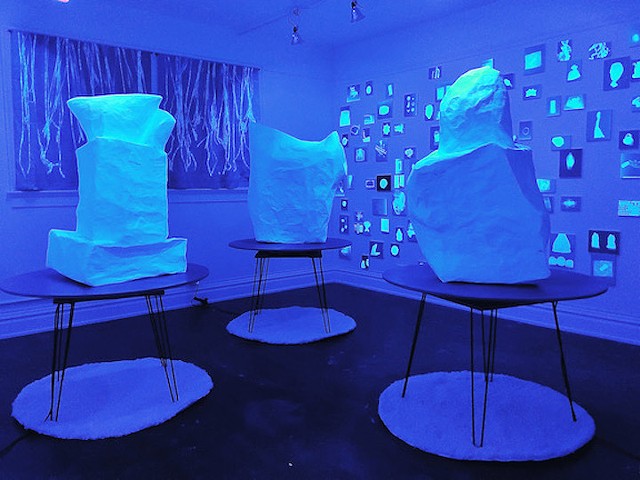Service Merchandise
Sarah Hobbs and Hannah Israel investigate marks of human presence by observing how different cultures function throughout history. There is an intrinsic connection between how we make history, think, and leave our mark on the world.
Service Merchandise contemplates the way our culture memorializes the act of presenting objects as commodities and gifts to represent a moment of desire. The installation is saturated with images of objects on the walls, large obscure sculptures rotating in the middle of the space, and in the background, a presence of muzak brings together a dream-like showcase. Israel and Hobbs amplify the absurdity of our culture's obsession with objects by setting a hyper-real display under black light creating an illusion and deceptive appearances.
In this installation, Hobbs and Israel illustrate the object’s power to create desire. Lacan states, "Objet petit a” is a fantasy that functions as the cause of desire; as such, it determines whether desire will be expressed within the limits of the pleasure principle or “beyond,..” Hobbs and Israel investigate showcases as a form of display and lure. They connect multiple ways desire is experienced from the moment of looking, wrapping and giving. For example, the purpose of wrapping is a daily human practice of using one object to frame another object as important.
Israel and Hobbs illustrate the act of wrapping objects, a practice that exemplifies power and desire through the hierarchy of objects as gifts. The art historian Cynthia Hahn has recently labeled this phenomenon the “reliquary effect.” The idea of religious relics as objects of power is created by those who wish to elevate both the objects and the owner. As crafted receptacles, reliquaries are typically beautiful and refined. They function two ways, one is to enclose an object and the other is to sensationalize the idea of the object. The container sets the stage of mystery and preciousness, that both hides and reveals. In Hahn’s observation, the “reliquary finds its purpose in stimulating attention and capturing desire.” This ties in how we present objects on display. It represents the fleeting nature of human experience, the birth and death of objects and ideas throughout history. Ultimately, the installation is a psychological space, inviting viewers to a new understanding of the shape of all things.



